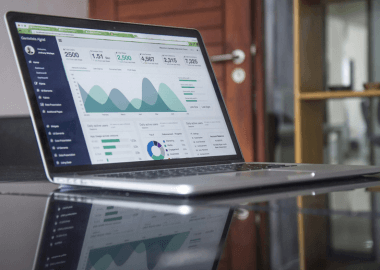8 Types of Web Portals and How They Benefit Your Business
A web portal is a simple solution to a huge problem. It helps businesses, organizations, and communities gather scattered experiences, services, and information in one place. And provide easy 24/7 access for customers and clients online.
If you consider building a web portal for your business, this post will be a good starting point. In just a few minutes, you will learn about the major types of web portals, explore key features and benefits of implementing a web portal, and see how companies solve various business challenges by integrating custom portals into their operations. You will also see several web portals examples from industry-leading companies, including DHL, Walmart, Oxford University Press, and more.
By the end of this post, you will have all you need to start shaping your idea and begin your own web portal development project.
Before we get to the types and examples of web portals, let’s first define what a web portal is and clarify the difference between a web portal and a website.
A web portal is a dynamic and interactive web system that works as a one-stop access point for users to explore content, products and services and communicate with brands. Depending on the type of business or organization that runs it, a web portal can act as a major source of information, a point of sale, or even a collaboration environment. It is usually available globally on any browser, though there are types of web portals that can only be reached via private networks (intranet, extranet).
Some of the most popular types of portals are student portals that give learners access to educational content and allow them to collaborate with peers and tutors. eCommerce portal is another common example of a web portal that allows customers to browse through products, make orders, manage payments and rewards.
Web portal vs. website

A web portal is a feature-rich web system that provides a certain target audience (customers, employees, vendors, etc.) with specific and often personalized content and services. In many cases, it requires authorized access (sign in, log in). Ideally, a web portal is seamlessly embedded into the company’s operations and integrated with other business applications (CRM, ERP).
On the contrary, a website is open to a much wider audience and provides more or less the same value to everyone. It is less interactive and has limited options to connect with the brand (contact forms, live chat, links to social media).
These types of portals have already been tested by companies across major industries including retail, education, healthcare, logistics, and finance. In fact, you probably use one of these web portals daily.
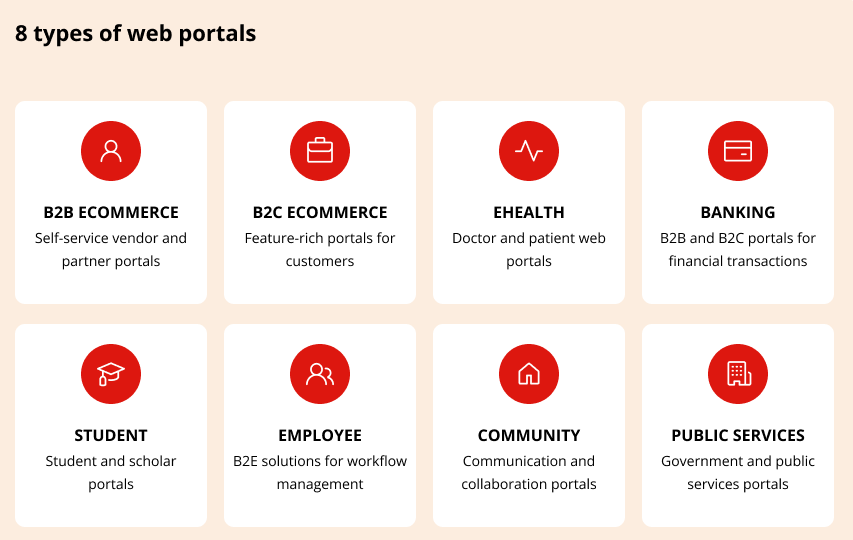
eCommerce portals
B2B and B2C eCommerce portals are designed to simplify and speed up communication and transactions between sellers and buyers. These portals are integrated into the company’s digital infrastructure and supply chain process and work as a sales, marketing and customer/client support instrument.
B2B eCommerce portal
B2B eCommerce portal is a self-service gateway where businesses can easily order and buy products and manage relationships with vendors and partners in one place. More and more wholesalers, manufacturers, distributors, and other companies allocate funds to vendor portal development seeking to cut costs, optimize the purchasing cycle, and increase efficiency.
The importance of web portals in B2B eCommerce increased significantly after COVID hit all the markets and disrupted supply chains all over the world. It is predicted that the demand for B2B online marketplaces and eCommerce integration will only grow in the future.
B2B eCommerce portal example
DHL provides eCommerce B2B customers with an interactive web portal for managing and tracking shipments online. It offers several neat features such as shipment history and label printing, making it easier for business customers to arrange shipping and monitor performance.

Image credit: DHL
B2C eCommerce portal
These are some of the most popular types of portals. Unlike regular online stores where users browse through products, make a purchase, and go, B2C portals provide customers with a range of valuable features that increase retention and improve user experience – user account, order history, rewards management, eWallets, personalized content, offers, and discount programs, etc.
B2C eCommerce web portal example
Printique is an all-in-one web system that provides users with a rich set of eCommerce features for creating and ordering products online, tracking and managing shipping, setting preferences, and building custom products. The system is integrated into Printique’s operations and connected to multiple 3rd party services (payment, login, tracking, photo upload) that make the customer experience consistent and smooth. Learn how we help Printique provide a superior web experience for over a decade…
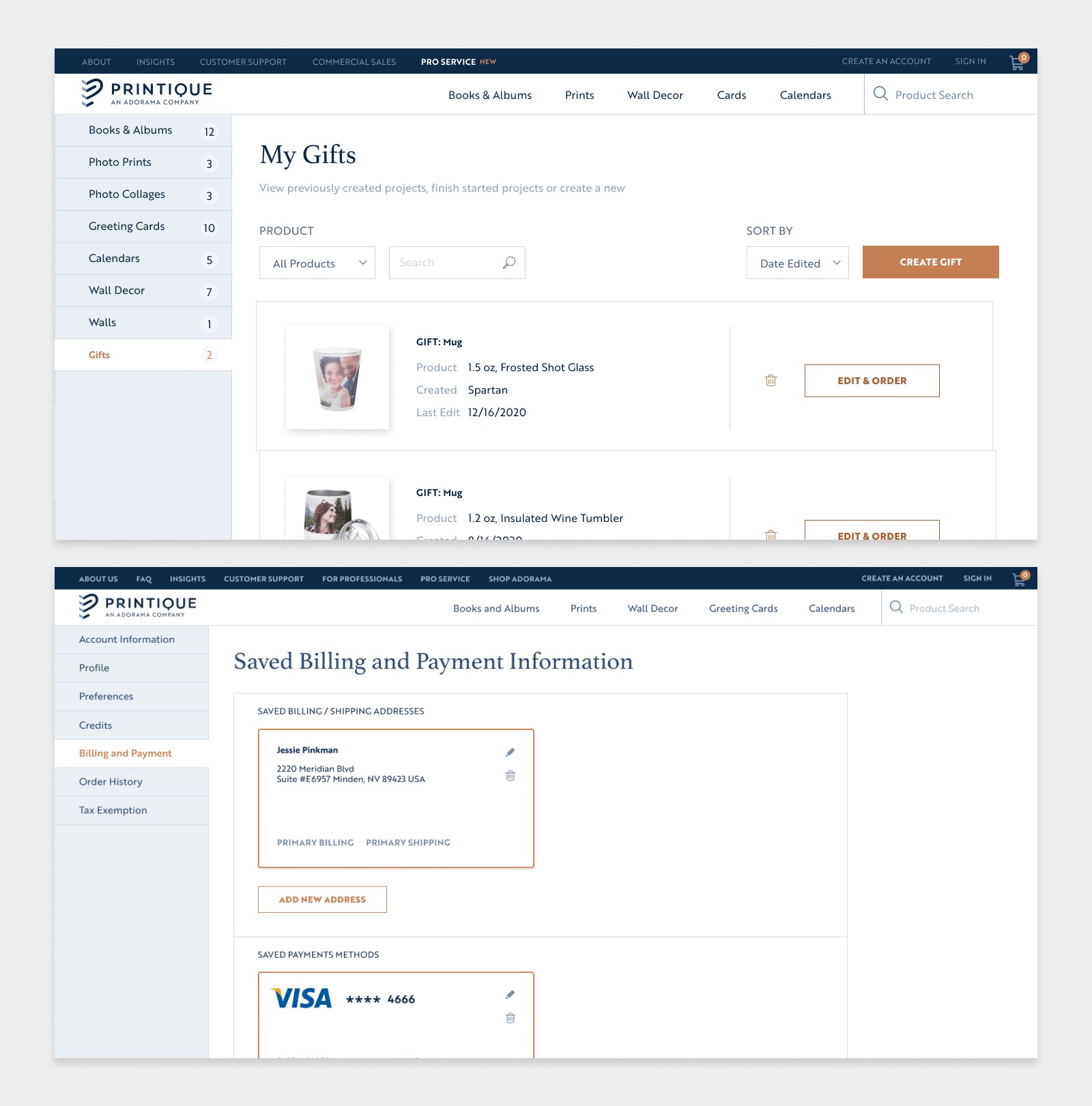
Benefits of eCommerce portals
B2B and B2C brands alike benefit from web portal creation in various aspects.
- Reduce time to sale, improve buyer journey, and boost repeat sales.
- Easily expand market presence and reach new audiences anywhere.
- Reduce customer support and operating costs.
- Enable seamless cost-effective scalability to new markets.
- Provide personalized experiences, upsell products and services.
Create better experience for your customers
Gather scattered services, data, and experiences into one intuitive enjoyable workflow. Your customers will thank you.
SHOW WEB PORTAL SERVICESeHealth web portals
eHealth portals for doctors and patients made a huge impact on healthcare outcomes, specifically on the patient experience and effectiveness of care.
Patient web portals are designed to provide patients with secure access to their healthcare data (appointments, test results, medical history, etc.) and allow them to contact and communicate with health and social care providers – doctors, clinics, and hospitals. Among the most popular features of patient portals are appointment booking, medical history, messaging, and prescription renewals.
Doctor portals act as an online workspace where healthcare professionals can get essential up-to-date information on their patients and practice operations. It is often part of a larger healthcare management system integrated with web EHR (EMR) and practice management tools.
eHealth portal example
Finnish My Kanta is perhaps one of the most significant web portal examples in healthcare with a whopping 89% adoption rate at a national level. The users of MyKanta can access and manage medical records, request prescription renewals, view test results, and get social services data all in one place.
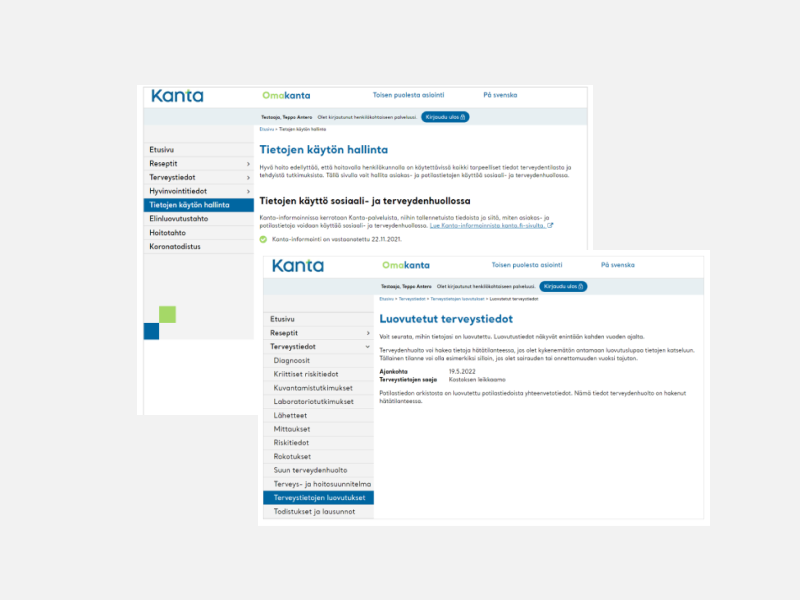
Image credit: My Kanta
Benefits of eHealth portals
Multiple advantages of web portals for doctors and patients positively affect the healthcare experience.
- Enhance patient engagement and medication adherence.
- Improve doctor-to-patient communication making it more convenient and accessible.
- Optimize healthcare workflows and remove inefficiencies that lead to long lines and waiting times at the hospital.
- Enable cost reduction and administrative savings.
- Provide a secure platform for storing and accessing medical records.
Financial and banking portals
One of the most common types of web portals that we use every day is a banking web portal that provides access to banking services and allows authorized users to securely make transactions online. Financial portals are used by investors and brokers to receive up-to-date financial information and market news, drill and analyze data, etc.
Banking portal example
Chase Business is a great web portal example with a rich set of features for managing business accounts online. It allows Chase customers to monitor account activity, control cash flow, and securely transfer funds from anywhere.
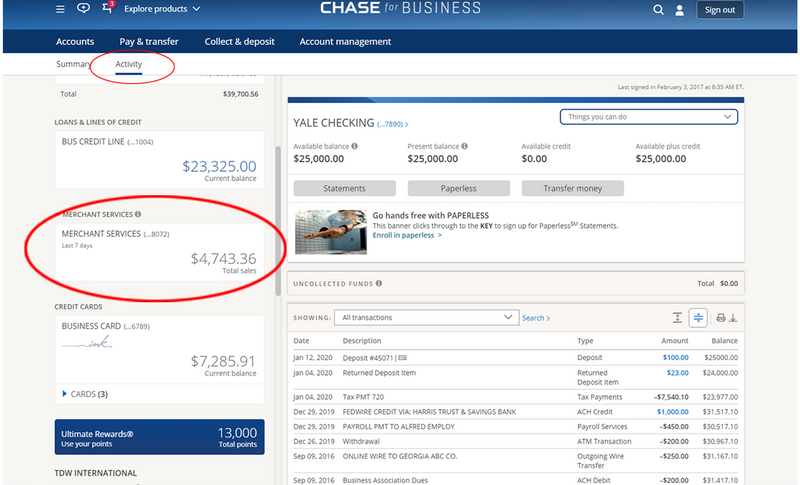
Image credit: JPMorgan Chase & Co
Benefits of banking portals
The primary web portal purpose in banking is to enable secure transactions online and ensure the traceability and safety of financial data.
- Provide secure access to banking and financial services 24/7.
- Automate recurring payments and reduce the risks of accumulating debt.
- Gain visibility into financial operations and simplify budgeting and expense tracking.
- Protect financial information and transactions online.
- Eliminate paperwork and manual financial management.
Student portals
Student portals are popular types of web portals used in education and eLearning. They are widely adopted by colleges and universities to provide students with important information about curriculum and campus life and help them manage the educational process and track progress.
Student portal example
Perfect real-world web portals examples in education are an applicant portal of Harvard College and my.harvard web portal for Harvard University students. These portals serve undergraduate and graduate students at different stages of their educational journey, providing essential features to apply for programs online, manage administrative tasks, and take part in faculty activities.
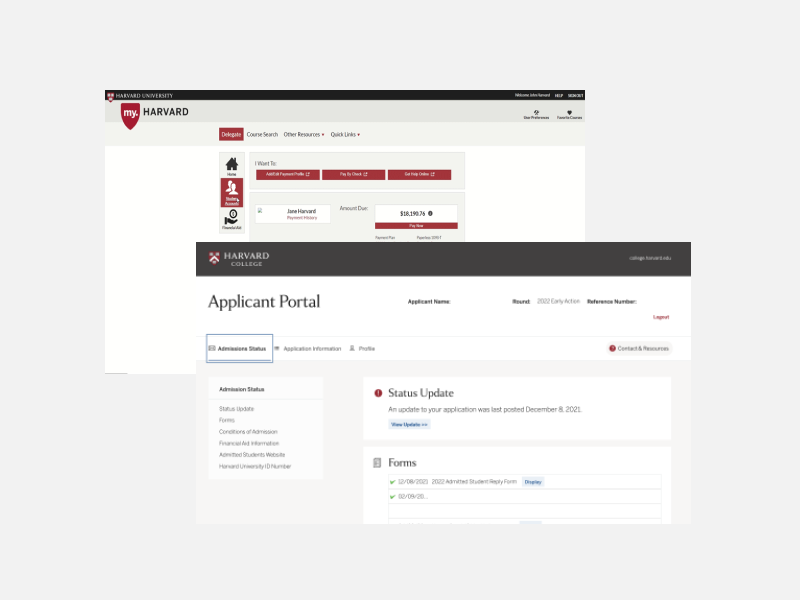
Image credit: Harvard College, Harvard University
Student portal benefits
Web portal is essentially a centralized hub where students can get the information and support they need for successful learning and enjoyable life on campus.
- Provide easy access to academic information, course and research materials, schedules, and grades, enhancing the learning experience.
- Help students integrate into the community faster and get help on the go.
- Give students online space to connect to professors, advisors, and peers, improving collaboration and support.
- Simplify administrative tasks and payments online.
- Enable tracking progress and planning an educational journey.
Employee portals
Employee portals help the company’s staff easily access work-related information (training programs, schedules, workflow data) and tools for project management and collaboration. Similar to other web portal types, B2E portals are usually integrated into the company’s infrastructure and, in some cases, are available only via corporate private networks.
Employee portal example
Among the most common web portal examples for employees are self-service portals and employee management software. For instance, OneWalmart that allows Walmart employees to manage schedules and leaves, view benefits and rewards, access training resources, and navigate career opportunities.
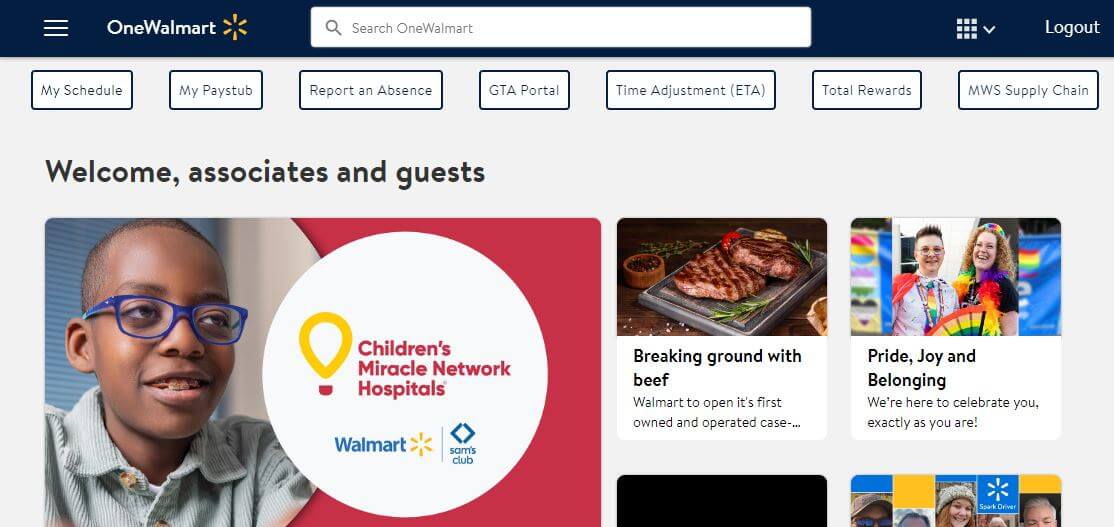
Image credit: Walmart
Employee portal benefits
Employee web portals are useful tools for organizations to improve employee experience and optimize HRM and recruiting process.
- Increase employee engagement and contribute to a positive work culture.
- Give a 360-degree view of the employee lifecycle for data-driven retention strategies and optimized performance management.
- Consolidate administrative and HR tasks and promote employee independence.
- Reduce time and cost by automating HR operations.
- Enhance employee data safety, accuracy, and compliance.
Community portals
This is a diverse category since community portals can be used for many different purposes from managing common assets to providing a small community with an online platform for collaboration.
Community portal example
Oxford Dictionaries Forum is among the simplest web portal examples. It works as an online communication space for language learners, developers and scholars who work with Oxford Languages content and resources on different projects.
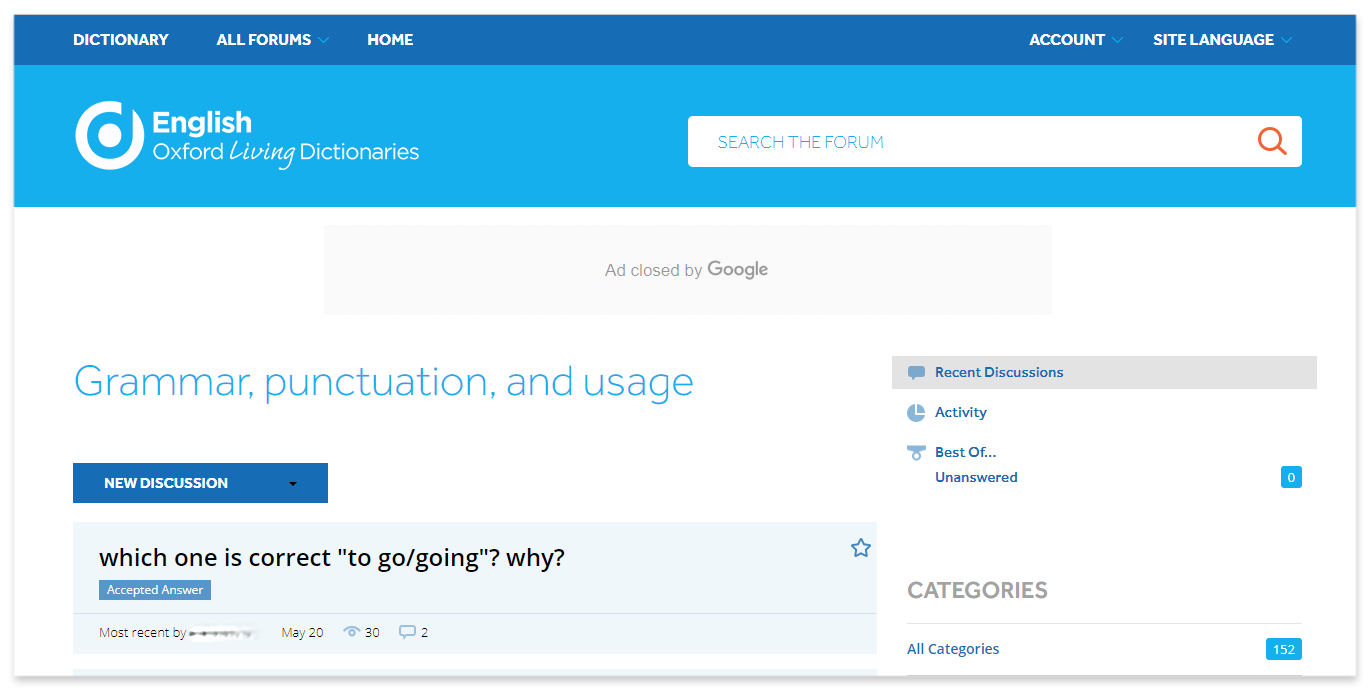
Community portal benefits
Just like every web portal with examples in education, healthcare, and eCommerce that we have already mentioned, community portals provide a wide range of benefits.
- Foster communication and collaboration.
- Facilitate knowledge sharing among community members.
- Promote social interaction and engagement.
- Help manage common assets efficiently.
- Provide tools for organizing and holding community events.
Public services and government portals
Web portals for public services and government portals are used worldwide to provide citizens with fast and convenient access to all important information such as taxation, employment, immigration, law, and so on. The best web portal example in this category would be a national, state, or city portal that serves the citizens of a certain country.
As we went through the main types of web portals with examples, you might have noticed that they share many features. Some of them are essential and therefore get into the original scope during MVP web development. So if you plan to build a web portal, consider the following features.
User registration/login
User registration and login are the core features that help recognize users, provide them with access to their data, and customize content and offers on the portal. Depending on the purpose of the web portal, user authorization may be obligatory or optional and have different security and log-in requirements. For example, an online banking portal often requires two-factor authentication while an eCommerce platform provides users with social login for easy access.
Profile and activity dashboard
Profile setup and activity dashboards are popular features for different types of web portals. These features usually store important information about registered users including their preferences, activity records and history. This data helps personalize content and user experience.
Personalized content and services
By providing personalized content and services tailored to specific customer or business needs, companies increase loyalty and improve business relationships. These features are particularly useful on multifunctional portals that provide different types of products and services to various target audiences.
Communication/collaboration features
Communication features such as chats, voice and video calls are frequently used on eCommerce, eHealth, eLearning and community platforms, as we’ve mentioned in many real-time examples of web portals before.
Integrations
Web portals are often integrated with 3rd party platforms and the company’s custom-built software and infrastructure to provide users with a smooth experience and optimize operations and workflows. Integrations with 3rd party tools and in-house infrastructure must be considered before building an architecture diagram for web application and web portal to avoid costly changes in the future.
Domain-specific features
Depending on the type of web portal or a business problem it solves, it may have domain-specific features such as interactive calendars on a patient portal or product and services listings on customer portals.
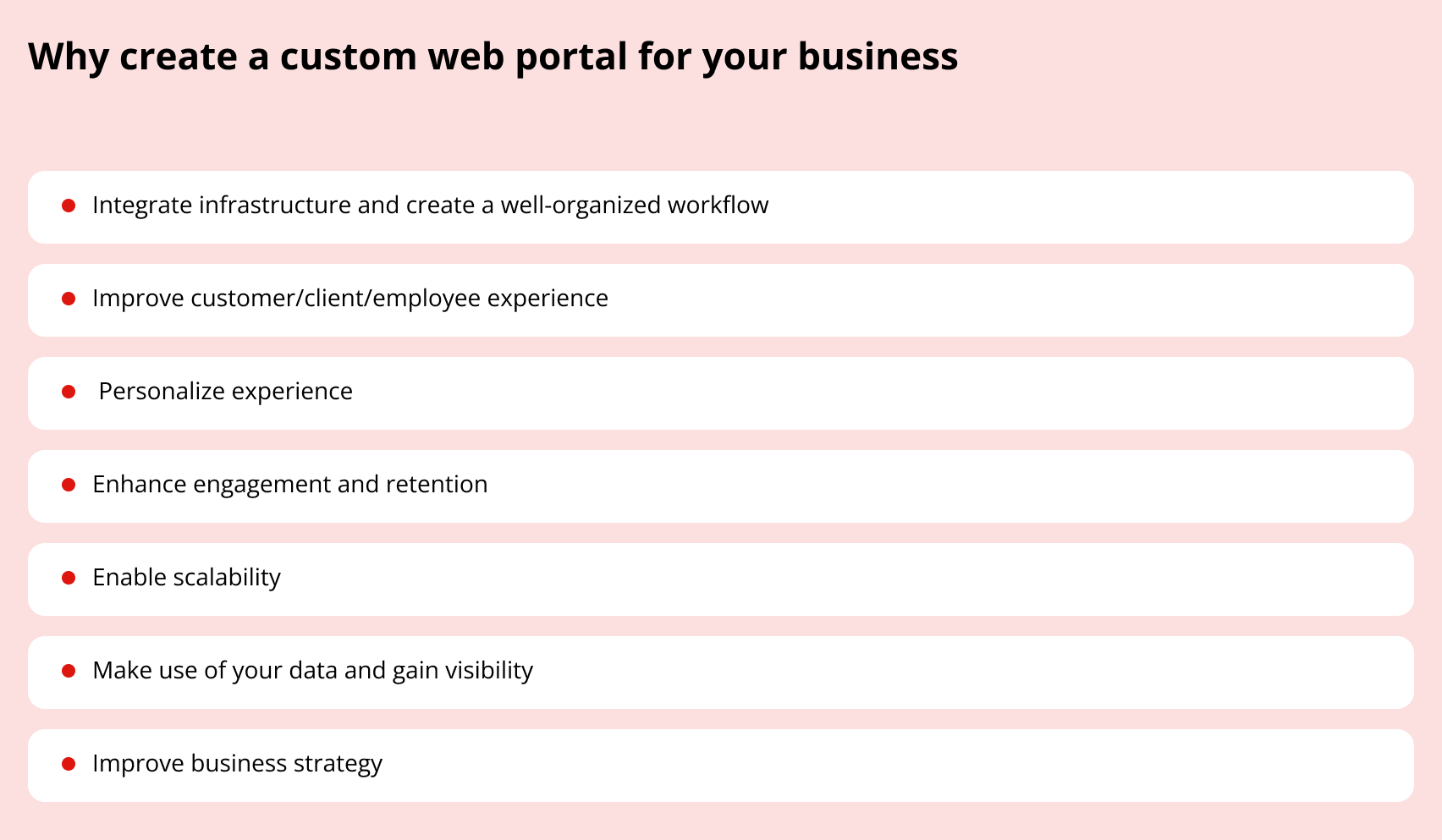
Now that we answered the question What are the types of web portals? and went through a few real-world examples, let’s also highlight Why use web portals? and go through the key benefits and practical reasons to adopt a web portal in your organization.
- Integrate infrastructure. Use a web portal to connect different tools, web applications and 3rd party systems in one place and create a well-organized workflow.
- Improve experience. Provide customers, clients, and employees with a convenient online space where they can get access to your products and services and connect with your brand.
- Personalize experience. Leverage user data to personalize the experience and provide focused services and content to different target groups.
- Enhance engagement and retention. Build up relationships with clients and customers who regularly use your web portal.
- Enable scalability. Scale your web portal as your business grows, gains new customers and clients, and expands to new markets.
- Make use of your data and gain visibility. Integrate data analytics and visualization technologies to better understand your audience and process and make informed decisions.
- Improve business strategy. Gather insights and use them to refine your tactical decisions and overall business strategy.
Need a web portal application for your business? Tap into our decade-long experience in web development and user-centered design to create a feature-rich scalable web portal for your business. We will provide an accurate cost estimate to build a web portal based on your requirements and goals and end-to-end web portal development services, including:
- Business analysis and project management
- Discovery and planning
- UX/UI design and development
- Web portal engineering and testing
- Web portal integration
- Web portal support and scale-up
Digiteum team has successfully delivered dozens of web projects and deployed B2B and B2C web portals for eCommerce, healthcare, education, and other domains. Learn more about our UX and UI development services and custom web development services and see how we can use our rich experience and competencies to build a user-centric web solution for your business. Contact our experts to share your requirements and get an estimate for your web portal project.
Start your web portal project
We can design, develop and seamlessly integrate a web portal into your operations, without burning your budget and disrupting your process.
HIRE WEB PORTAL DEVELOPERS- A web portal is an effective modern solution that helps companies move their services and operations online.
- Some of the most popular types of web portals are used to drive sales and promote products and services, others are focused on providing users with content and collaboration tools.
- Most web portals share common features such as user registration/login, content/service personalization, and integrations with 3rd party services.
This post was originally published on February 2, 2022 and updated on October 16, 2023.






